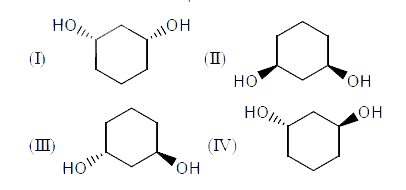Which of the following complexes will give a pair of enantiomers ?
A
[Pt(NH3)4][PtCl6]
B
[Co(NH4)Cl2]NO2
C
[Cr(NH3)6]Co(CN)6]
D
[Co(en)2Cl2]Cl
Text Solution
The correct Answer is:D
It is the correct answer.

|
Topper's Solved these Questions
- CO-ORDINATION COMPOUNDS BOOK - DINESH PUBLICATIONCHAPTER - CO-ORDINATION COMPOUNDS EXERCISE - Comprehension types
19 Videos
- CO-ORDINATION COMPOUNDS BOOK - DINESH PUBLICATIONCHAPTER - CO-ORDINATION COMPOUNDS EXERCISE - Straight objective type mcqs
17 Videos
- CO-ORDINATION COMPOUNDS BOOK - DINESH PUBLICATIONCHAPTER - CO-ORDINATION COMPOUNDS EXERCISE - Assignment
76 Videos
- CHEMISTRY IN EVERY DAY LIFEBOOK - DINESH PUBLICATIONCHAPTER - CHEMISTRY IN EVERY DAY LIFEEXERCISE - Unit test-9
50 Videos
- CYANIDES, ISOCYANIDES, NITROCOMPOUNDS AND AMINESBOOK - DINESH PUBLICATIONCHAPTER - CYANIDES, ISOCYANIDES, NITROCOMPOUNDS AND AMINESEXERCISE - Unit test - 8
20 Videos
Similar Questions
Knowledge Check
A pair of enantiomers is :
Aa pair of non superimposable mirror image of each otherBa pair of superimposable image of each otherCalways optically active if one is dextrorotatory then other will be leavorotatory by same magnitudeDcompounds having same boiling pointsA pair of enantiomers is:
Aa pair of non superimposable mirror image of each otherBa pair of superimposable image of each otherCalways optically active if one is dextrorotatory then other will be laevorotatory by same magnitudeDcompounds having same boiling pointsWhich of the following pair of compounds is a pair of enantiomers
A[Co(NH3)4Cl2]+B[Cr(en)3]3+C[Co(P(C2H5)3)2ClBr]Dtrans- [Co(en)2Cl2]+
Which of the following pairs of compounds is a pair of enantiomers?
View SolutionWich of the following paris of compounds is pair of enantiomers
View SolutionWhich of the following represents a pair of enantiomes?
View SolutionWhich of the following represetns a pair of enantiomers?
View SolutionWhich of the following represents a pair of enantiomers?
View Solution

